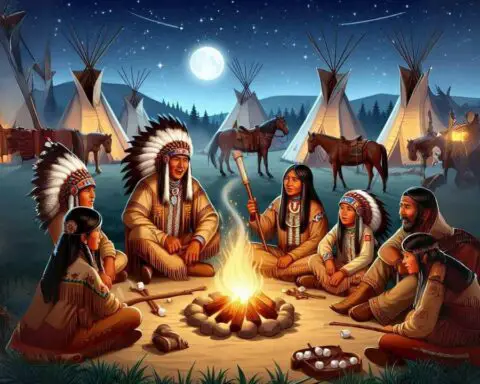Welcome to the exciting world of Thurgood Marshall, a true hero of justice and equality! Perfect for young learners, this page on Thurgood Marshall Facts For Kids is packed with engaging and easy-to-understand facts about Thurgood Marshall’s life, his groundbreaking work as the first African American Supreme Court Justice, and his tireless fight for civil rights. From his early life in Baltimore to his historic victories in the courtroom, discover how Thurgood Marshall’s dedication and courage changed America for the better. Get ready to be inspired by the remarkable story of a man who believed in fairness for all and worked hard to make it a reality.
Thurgood Marshall Facts For Kids
Introduction to Thurgood Marshall
Imagine a world where not everyone is treated equally, where the color of your skin determines where you can go to school, sit on a bus, or even drink water from a fountain. Now, imagine a brave person who stands up against these unfair rules, using nothing but his brain, his voice, and the power of the law to make a change. That hero is Thurgood Marshall.
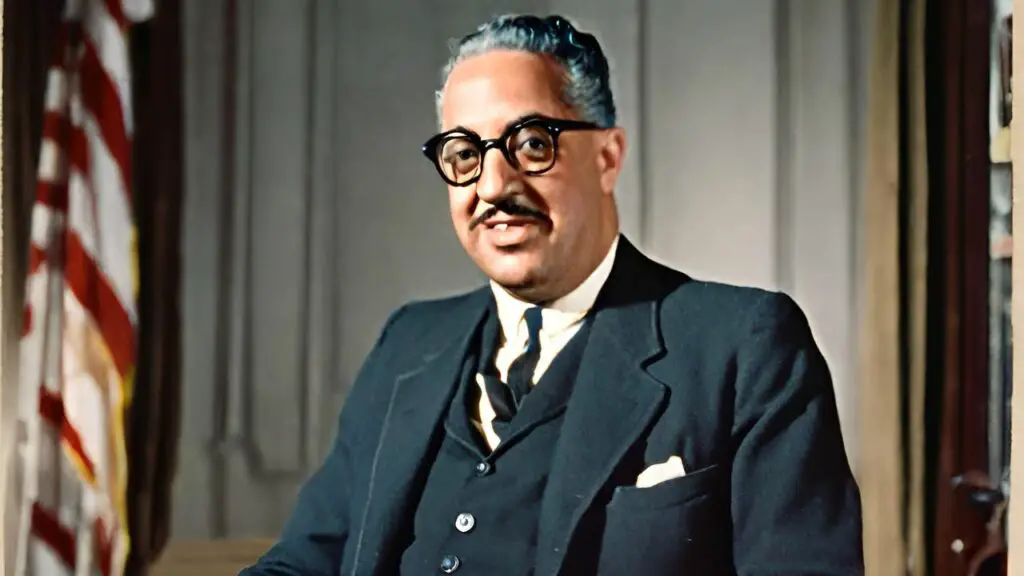
Who is Thurgood Marshall and What Did He Do?
Thurgood Marshall was a real-life superhero in the world of law and justice. Born on July 2, 1908, in Baltimore, Maryland, he grew up during a time when America was segregated. This means that black and white people were kept apart in schools, restaurants, and even on buses. Thurgood didn’t think this was fair, and he decided to do something about it.
He was super smart and worked really hard in school, even though he liked to play pranks! After finishing high school, he wanted to go to the University of Maryland Law School. But there was a big problem: they didn’t allow black students. Instead of giving up, Thurgood went to Howard University Law School, where he became the top student. He was like a sponge, soaking up all the knowledge on how to fight for justice.
After becoming a lawyer, Thurgood worked for the NAACP (National Association for the Advancement of Colored People). He traveled all over the United States, defending people who were treated unfairly because of their race. He fought for teachers who weren’t paid the same because they were black, for students who were denied entry to universities because of their skin color, and for many others facing injustice.
But Thurgood Marshall didn’t stop there. He took his fight all the way to the Supreme Court of the United States. One of his biggest battles was the case of Brown v. Board of Education. In this case, he argued that keeping black and white students in separate schools was not fair. The Supreme Court agreed, and in 1954, they made a landmark decision that said segregation in public schools was unconstitutional. This was a huge victory for Thurgood and for all people fighting for equality.
Thurgood Marshall’s superhero journey didn’t end there. In 1967, he became the first African American to serve on the Supreme Court. He was like a guardian of justice, making sure that the laws of the land were fair for everyone, no matter their color, for 24 years.
So, who was Thurgood Marshall? He was a fighter for justice, a brilliant lawyer, and a Supreme Court Justice who changed America for the better. He showed us that with courage, determination, and a belief in fairness, one person can make a huge difference in the world.
Early Life and Education
Let’s step back in time to the early 1900s, in the bustling city of Baltimore, Maryland. This is where the story of a young boy named Thurgood Marshall begins. Born on July 2, 1908, Thurgood was like any other kid, curious and full of energy. But he was growing up in a world that was divided by the color of people’s skin. This division wasn’t fair, and it was something that Thurgood would grow up to challenge.
Thurgood Marshall’s Early Life
Thurgood’s early life was filled with family, laughter, and lessons that would shape his future. His father, William Marshall, worked as a steward at an all-white country club, and his mother, Norma, was a kindergarten teacher. Thurgood had a brother named William Aubrey Marshall. His family wasn’t rich, but they were close-knit and full of love.
Thurgood’s dad had a unique way of teaching his sons about the world. He would take Thurgood to courtrooms to watch cases, and then they would discuss them at home. These discussions were like seeds planted in young Thurgood’s mind, growing his interest in law and justice.
Where Was Thurgood Marshall Born? Where Did He Grow Up?
Baltimore, Maryland, was Thurgood’s hometown, and it’s where he spent his childhood and teenage years. Baltimore in the early 20th century was a place of stark contrasts, with the beauty of its historic buildings shadowed by the ugliness of segregation. Thurgood saw firsthand the effects of inequality, and it was in the streets and schools of Baltimore that he began to dream of change.
Thurgood Marshall Education
Thurgood was a bright student, but he also had a playful side. He attended Frederick Douglass High School, where he was known for his wit and love of pranks. Despite his playful nature, Thurgood was deeply influenced by his teachers, who encouraged him to use his intelligence and voice for a greater purpose.
After high school, Thurgood wanted to attend the University of Maryland Law School. However, the school did not admit black students. This rejection was a direct encounter with the discrimination he wanted to fight. Instead of giving up, Thurgood went to Howard University Law School, a historically black university in Washington, D.C. There, he met Charles Hamilton Houston, a brilliant lawyer and professor who became Thurgood’s mentor. Under Houston’s guidance, Thurgood became the top student in his class. He soaked up every lesson on civil rights law, preparing himself for the battles ahead.
Howard University wasn’t just a place of learning for Thurgood; it was a forge where his determination and commitment to justice were tempered into steel. He graduated first in his class in 1933, armed with knowledge, passion, and a vision for a world where justice was blind to the color of one’s skin.
Career Before the Supreme Court
Before Thurgood Marshall became a legend in the halls of the Supreme Court, he was a warrior in the courtroom, fighting battles not with swords, but with words and wisdom. His career as a lawyer was like a superhero’s origin story, filled with challenges that tested his courage and determination.
Thurgood Marshall as a Lawyer
After graduating from Howard University Law School, Thurgood didn’t waste any time. He started working for the NAACP (National Association for the Advancement of Colored People), where he became the chief attorney. In this role, he was like a knight in shining armor, traveling across the country to defend people who were treated unfairly because of their race. He fought for teachers who were paid less because they were black, for students denied the right to attend certain universities, and for many others facing injustice.
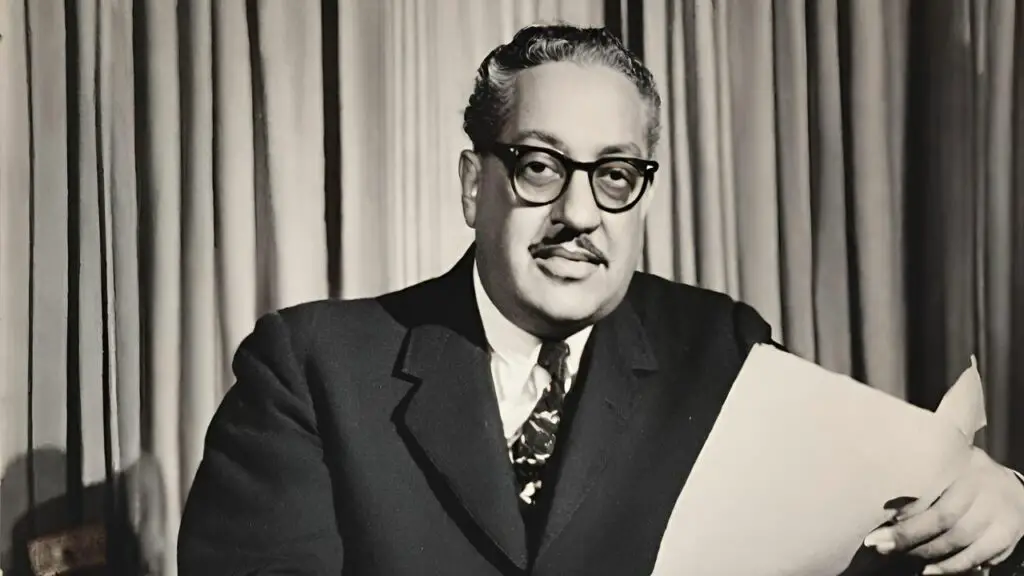
What Did Thurgood Marshall Fight For?
Thurgood Marshall fought for equality and justice. He believed that everyone, regardless of their skin color, deserved the same rights and opportunities. He battled against segregation – the unfair practice of keeping black and white people separate in schools, restaurants, and other public places. Thurgood knew that segregation was not just about physical separation; it was about telling black people they were less valuable, which he knew was wrong.
Thurgood Marshall and Brown v Board
One of Thurgood’s most famous battles was the case of Brown v. Board of Education. This case challenged the idea of “separate but equal” schools for black and white children. Thurgood argued that segregation in schools made black children feel inferior and that “separate but equal” was a lie because the schools were not equal at all. In 1954, the Supreme Court agreed with Thurgood, ruling that segregation in public schools was unconstitutional. This victory was a giant leap forward in the fight for civil rights, and it showed the world that change was possible.
What Did Thurgood Marshall Do in the Civil Rights Movement?
Thurgood Marshall was a key figure in the civil rights movement, using his legal expertise to challenge and dismantle the laws and practices that kept black Americans oppressed. He didn’t just work on education cases; he also fought against discrimination in voting, housing, and employment. Thurgood’s work laid the groundwork for many of the civil rights victories that followed, including the Civil Rights Act of 1964 and the Voting Rights Act of 1965.
Thurgood Marshall’s career before the Supreme Court was marked by his unwavering commitment to justice. He was a brilliant strategist, a passionate advocate, and a tireless fighter for the rights of all Americans. His legacy is not just in the laws he helped change but in the lives he touched and the path he blazed for future generations to follow. Through his courage and dedication, Thurgood Marshall showed us that one person can make a difference and that the fight for justice is always worth it.
Supreme Court Justice
After years of fighting for justice in courtrooms across the country, Thurgood Marshall took on a new role that would cement his legacy as a champion of civil rights. He became a Supreme Court Justice, the first African American ever to hold this prestigious position. It was like stepping onto a grand stage where the decisions he helped make would shape the future of America.
Who Appointed Thurgood Marshall to the Supreme Court?
It was President Lyndon B. Johnson who saw the brilliance and the potential in Thurgood Marshall to serve on the highest court in the land. On June 13, 1967, President Johnson nominated Marshall to the Supreme Court, saying it was “the right thing to do, the right time to do it, the right man and the right place.” Johnson was known for his commitment to civil rights, and appointing Marshall was a bold move that showed his determination to change America for the better.
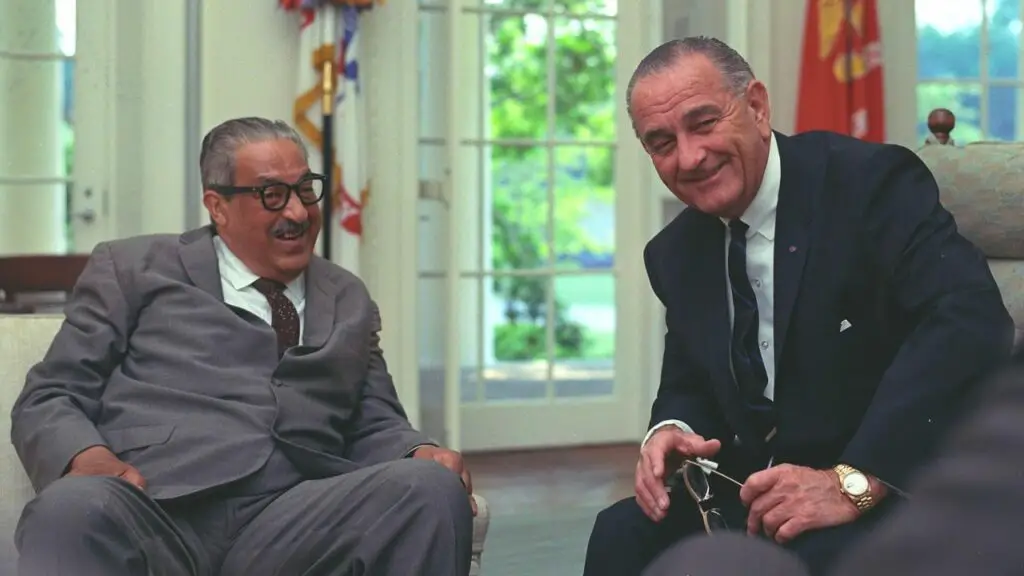
When Did Thurgood Marshall Join the Supreme Court?
Thurgood Marshall officially became a Supreme Court Justice on October 2, 1967, after being confirmed by the Senate. This historic moment wasn’t just a personal achievement for Marshall; it was a victory for all those who had fought for equality and justice. It was a sign that America was moving forward, slowly but surely.
How Long Did Thurgood Marshall Serve on the Supreme Court?
Thurgood Marshall served on the Supreme Court for an impressive 24 years. During his time on the bench, he continued his fight for civil rights, advocating for the voiceless and the oppressed. He was known for his passionate opinions and his unwavering commitment to justice. Marshall retired in 1991, leaving behind a legacy that would inspire future generations.
Was Thurgood Marshall a Supreme Court Justice?
Yes, Thurgood Marshall was not only a Supreme Court Justice, but he was also a symbol of progress and hope. His journey from the streets of Baltimore to the highest court in the land is a testament to his determination, intelligence, and commitment to equality. As a Justice, Marshall used his position to advocate for fair treatment for all Americans, regardless of their race, gender, or economic status. He believed in a more just and equitable society, and he worked tirelessly to make that vision a reality.
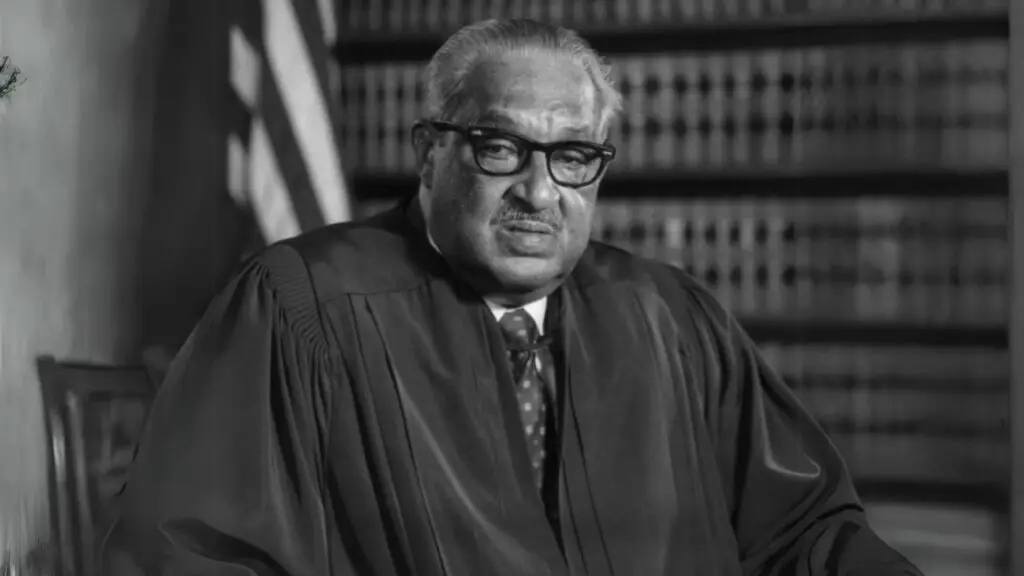
Thurgood Marshall’s tenure as a Supreme Court Justice was marked by his deep understanding of the law and his compassion for people. He knew the power of the law to change lives, and he used that power wisely. Marshall’s legacy is not just in the legal precedents he helped establish but in the countless lives he touched through his work. He showed us that justice and equality are worth fighting for, and he left an indelible mark on the American legal system.
Legacy and Impact
Thurgood Marshall was more than just a lawyer or a Supreme Court Justice; he was a beacon of hope and a catalyst for change in a country struggling with the deep scars of racial inequality. His legacy is a tapestry of battles fought and won in the name of justice, equality, and the promise of a better America.
How Did Thurgood Marshall Change the World?
Thurgood Marshall changed the world by tearing down the legal foundations of segregation and discrimination in the United States. Through his work with the NAACP and his landmark victory in Brown v. Board of Education, Marshall challenged and ultimately dismantled the doctrine of “separate but equal,” proving that segregation was inherently unequal and unconstitutional. This decision paved the way for the civil rights movement, inspiring a generation to stand up for their rights and demand equal treatment under the law.
Why is Thurgood Marshall Important?
Thurgood Marshall is important because he embodied the ideals of justice and equality that lie at the heart of the American dream. He showed that the law could be a powerful tool for change and that one person’s courage and determination can make a difference. Marshall’s work helped to transform American society, making it more just and equitable for all its citizens. His legacy serves as a reminder of the ongoing struggle for civil rights and the importance of standing up for what is right.
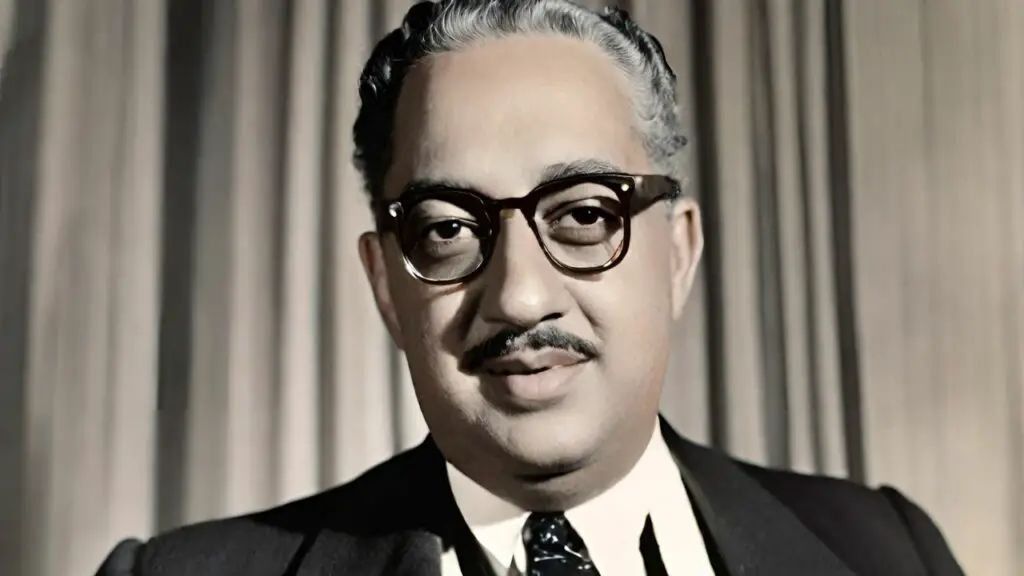
Contributions of Thurgood Marshall
Thurgood Marshall’s contributions extend far beyond his victory in Brown v. Board of Education. As a Supreme Court Justice, he was a vocal advocate for the rights of the marginalized and the oppressed, consistently voting to expand civil rights, uphold affirmative action, and protect the rights of workers, women, and the accused. Marshall’s opinions and decisions helped to shape the legal landscape of America, ensuring that the principles of fairness and equality applied to everyone.
What Did Thurgood Marshall Accomplish?
Thurgood Marshall’s accomplishments are numerous and profound. He won more cases before the United States Supreme Court than any other American. Beyond Brown v. Board of Education, he fought for the right to a fair trial, the right to vote, and the right to equal access to public facilities and education. As a Justice, he continued to fight for a more inclusive vision of America, one where every person’s rights are protected, and every voice is heard. Marshall’s work laid the foundation for much of the progress in civil rights and liberties that followed, making him one of the most influential figures in American legal history.
Thurgood Marshall’s legacy is not just in the laws he helped to change or the decisions he made on the Supreme Court. It’s in the lives he touched, the society he helped to transform, and the enduring belief that justice and equality are not just ideals, but rights that belong to every American. Through his life and work, Thurgood Marshall showed us that with perseverance, courage, and faith in the power of the law, it is possible to change the world.
Interesting Facts About Thurgood Marshall
Thurgood Marshall’s life and career are filled with remarkable achievements and fascinating stories. Beyond his monumental legal battles and his tenure as the first African American Supreme Court Justice, there are many interesting facts that showcase his personality, his passions, and his unique path through history.
Thurgood Marshall Fun Facts
- Nickname: As a young boy, Thurgood was nicknamed “Goody” by his family. It was a short form of his original name, Thoroughgood, which he later shortened to Thurgood in the second grade to make it easier to write.
- Prankster in School: Marshall was known for his sharp wit and sense of humor, often playing pranks on his classmates. Despite his playful nature, he was deeply committed to his studies, especially when it came to the law.
- Passion for Listening to Cases: Inspired by his father, Thurgood developed a love for the law at a young age. They would visit the local courthouse together, where Thurgood would listen intently to cases, sparking his interest in justice and civil rights.

Interesting Facts About Thurgood Marshall
- Loves to Cook: Marshall was not only a brilliant lawyer and justice but also an avid cook. He enjoyed preparing meals, a hobby that offered him a break from the rigors of legal work.
- A Voracious Reader: Marshall had an insatiable appetite for reading, consuming books on a wide range of topics. This love of reading helped him to become a well-rounded thinker and an effective advocate.
- Jazz Enthusiast: He had a deep appreciation for jazz music, which was reflective of his vibrant personality and deep cultural roots.
10 Interesting Facts About Thurgood Marshall
- Historic Senate Vote: His appointment to the Supreme Court was confirmed by a Senate vote of 69 to 11, a significant margin that underscored his qualifications and the respect he commanded.
- FBI Surveillance: Like many civil rights leaders of his time, Marshall was monitored by the FBI, a testament to his influential role in the fight for equality.
- International Influence: Marshall also worked on constitutional law in emerging nations, including helping to draft the constitution of Kenya.
- Legacy in Education: Several schools across the United States are named in honor of Thurgood Marshall, a tribute to his impact on education and civil rights.
Thurgood Marshall’s 3 Major Accomplishments
- Brown v. Board of Education (1954): Marshall’s argument before the Supreme Court led to the unanimous decision that declared state laws establishing separate public schools for black and white students to be unconstitutional, overturning Plessy v. Ferguson.
- First African American Supreme Court Justice (1967-1991): His appointment and service on the court broke racial barriers and paved the way for future generations of minorities in law and politics.
- Champion of Civil Rights: Beyond Brown v. Board, Marshall won numerous cases before the Supreme Court that challenged racial segregation and discrimination, contributing significantly to the advancement of civil rights in America.
Conclusion: The Enduring Legacy of Thurgood Marshall
Thurgood Marshall stands as a towering figure in American history, not just for his groundbreaking role as the first African American Supreme Court Justice, but for his tireless fight for justice and equality. His fame and enduring legacy are built on his profound impact on society, his contributions to civil rights, and his unwavering belief in the power of the law to effect change.
Why Thurgood Marshall is Famous
Thurgood Marshall is famous for his pivotal role in the civil rights movement, most notably for his victory in Brown v. Board of Education, which led to the desegregation of public schools in America. His appointment to the Supreme Court was another milestone, breaking racial barriers and setting a precedent for future generations. Marshall’s legal genius, compassion, and dedication to justice transformed the American legal landscape, making him a symbol of progress and equality.
Thurgood Marshall’s Impact on Society
Marshall’s impact on society extends far beyond the courtroom. He changed the course of American history, challenging and dismantling systemic racism through the power of the judiciary. His decisions and opinions as a Supreme Court Justice helped to uphold civil liberties, protect individual rights, and ensure justice for all Americans, regardless of race or background. Marshall’s legacy is a testament to his belief that “equal justice under law” is not just an ideal, but a fundamental right.
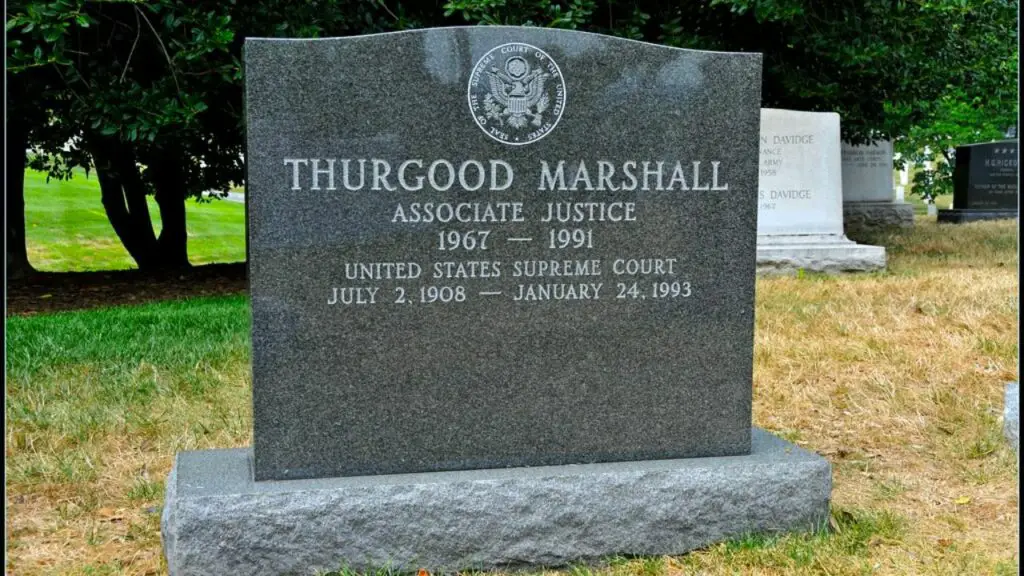
Additional Information
- Thurgood Marshall Family Life: Marshall was married twice, first to Vivian “Buster” Burey until her death in 1955, and then to Cecilia Suyat, with whom he had two sons, Thurgood Marshall Jr. and John W. Marshall. His family life was marked by love, resilience, and the shared commitment to civil rights.
- Thurgood Marshall Famous Quote: One of his most famous quotes encapsulates his philosophy: “In recognizing the humanity of our fellow beings, we pay ourselves the highest tribute.” This quote reflects Marshall’s deep belief in dignity, equality, and justice for every individual.
- Movies About Thurgood Marshall: His life and legacy have been depicted in several films, including “Marshall” (2017), which focuses on one of his early cases as a young lawyer. These films offer a glimpse into the challenges he faced and the victories he achieved in his fight for justice.
- How Did Thurgood Marshall Die?: Thurgood Marshall passed away on January 24, 1993, at the age of 84, due to heart failure. His death marked the end of an era but the beginning of a lasting legacy.
- Where is Thurgood Marshall Buried?: Marshall is buried at Arlington National Cemetery, a place of honor, reflecting his significant contributions to the nation and his status as a true American hero.
Thurgood Marshall’s life story is one of courage, perseverance, and an unwavering commitment to justice. He broke barriers, challenged injustices, and dedicated his life to ensuring that America lived up to its promise of equality for all. His legacy continues to inspire and influence not just the legal community, but all who believe in the power of justice and the importance of fighting for what is right.






